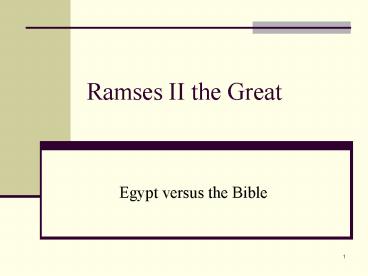Ramses II the Great - PowerPoint PPT Presentation
1 / 14
Title: Ramses II the Great
1
Ramses II the Great
- Egypt versus the Bible
2
Outline
- Introduction
- Part I. Ramses II
- a. His reign
- b. His life and his family
- Part II. Moses and the Bible?
- a. Moses
- b. The Jews in Egypt
- c. The Red Sea
- Conclusion
- References
3
Introduction
- Ramses II (r. 1290-1224 B.C.), one of the longest
reigns of any Egyptian pharaoh - Third ruler of the 19th Dynasty, son of Seti I
- Reign marked last peak of Egyptian imperial
power famed for his massive building programs
and many colossal statues - Ramses is thought to be the pharaoh referred to
in the biblical book of Exodus
4
Part I. Ramses II
5
a. His reign
- The son of Seti I and Queen Tuya was the third
king of the 19th Dynasty. Called Ramesses the
Great, he lived to be 96 years old - Ramses assumed the throne and began a series of
wars against the Syrians. The famous Battle of
Kadesh is inscribed on the walls of his temple - Ramesses' building accomplishments are two
temples at Abu Simbel, the hypostyle hall at
Karnak, a mortuary complex at Abydos, the
Colossus of Ramses at Memphis, a vast tomb at
Thebes, additions at the Luxor Temple, and the
famous Ramesseum
6
Abu Simbel
7
b. His life and his family
- Ramses had 200 wives and concubines, 96 sons and
60 daughters Among his wives were Nefertari,
Queen Istnofret, and a Hittite princess - Nefertari, daughter of King Seti I, and thus
sister or half sister of Ramses II, was his
favorite Queen - Her participation in the affairs of the state is
unparalleled referred as the "Great King's Wife - A political role is also reflected by the
recurrent designation "Lady of Upper and Lower
Egypt" and "Lady of the Two Lands"
8
Part II.Moses and the Bible
9
a. Moses
- Born in Goshen, a part of ancient Egypt
- His mother placed him in a basket made of papyrus
and set it floating on the Nile River - Rescued by the daughter of Pharaoh, who brought
the infant up as her own child - Moses went to Pharaoh, but in spite of the
miracles he worked, Pharaoh would not release the
Hebrew people - At last, he consented, and Moses led the Hebrews
out of Egypt (Exodus) - Moses received the Ten Commandments from God on
Mount Sinai, but smashed the tablets when he
found the Israelites worshiping a golden calf
10
b. The Jews in Egypt
- The Hebrews lived in Egypt and were oppressed by
the Egyptian ruler - After the Israelites spend two centuries enslaved
in Egypt, God chooses Moses, an Israelite who has
fled from Egypt, to lead the children of Israel
out of slavery - Historians can verify none of this narrative
Jews honor the story of the miraculous departure
from Egypt, called the Exodus, as the
transforming event in Jewish history
11
c. The Red Sea
- Narrow, inland sea, separating the Arabian
peninsula, western Asia, from northeastern Africa
(1,900 km long) - The site of the safe passage of the Israelites
through the Red Sea is said to be the Gulf of
Suez - The Red Seas high salt content is a result of
the regions extreme heat, which makes its waters
evaporate quickly
12
Red Sea
13
Conclusion
- Ramses II probably had about 100 children by his
principle wives and consorts - Unlike many pharaohs, his family is attested to
with numerous monuments including Nefertari's
small temple at Abu Simbel and her great tomb in
the Valley of the Queens - He also built a tomb for a number of his sons in
the Valley of the Kings on the West Bank at Luxor
(ancient Thebes) very near his own tomb - Interesting to note that Pharaoh released the
Hebrew people only when his son died
14
References
- http//www.touregypt.net/19dyn03.htm
- http//touregypt.net/historicalessays/nefertari.ht
m - http//www.sis.gov.eg/egyptinf/history/html/ramses
.htm - http//www.eyelid.co.uk/k-q4.htm
- http//www.bibleplaces.com/abusimbel.htm
- http//www.touregypt.net/featurestories/abusimbel.
htm - http//www.kfki.hu/arthp/bio/s/sluter/biograph.ht
ml - http//touregypt.net/historicalessays/nefertari.ht
m































